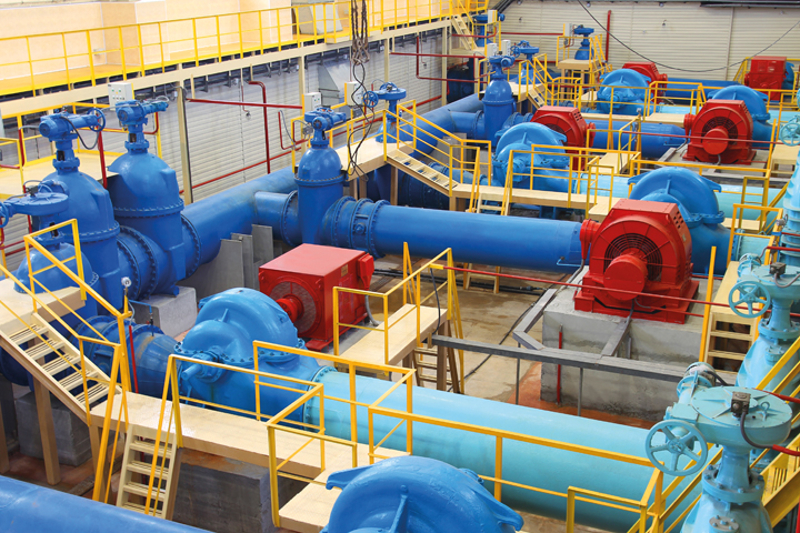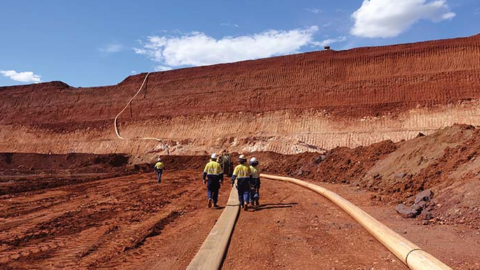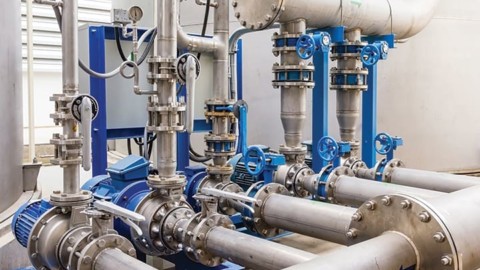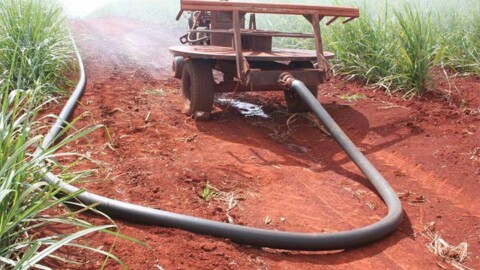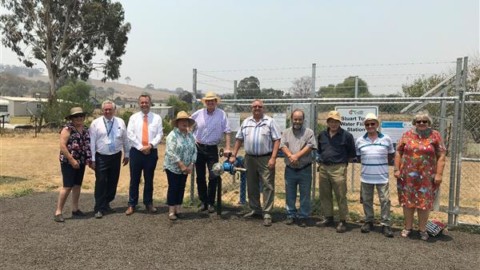In this part of our coverage of intake design we will discuss the various wet and dry well pump stations for single sump designs and multi sump designs both rectangular and circular.
Wet well and dry well pumping stations
A pump can be installed in a wet or dry well, as illustrated below, a vertical suspended pump in a wet well and a similar pump in a dry well. In a dry well, the bell mouth may be direct in the wall or turned down through an angle of up to 90° as shown in Figure 1. The wet well configuration has the advantage of simplicity and reduced civil costs and is widely used. However, maintenance can be a problem as it involves dewatering the pump or lifting the pump unit out of the well. The wet well arrangement is most suited for intermittent duty such as pumping stormwater, in which the well will be dry for most of the time.
The dry well configuration is usually used when reliability is a prime requirement since the pump is readily accessible at all times. The “turned down” bellmouth of in (c) is a popular arrangement in sewage applications since it allows a lower water cover in the sump compared with a horizontal intake (b) and in general is less prone to vortex action at similar water levels.
Single pump sump designs
The guidelines provided in this section are the basic sump dimensions for a satisfactory pump operation. Sump dimensions are defined in terms of bellmouth diameter. Bellmouth diameter is sized based on the recommended inlet bellmouth velocity. This varies between various manufacturers. However, recommended inlet bellmouth velocity is 1.7m/s. This may vary between 0.6m/s to 2.7m/s for flows up to 315L/sec. 0.9m/s to 2.4m/s for flows between 315 to 1260L/sec, and 1.2m/s to 2.1m/s for flows greater than 1260L/sec.
Single pump sumps – wet well arrangements
A basic design for a simple rectangular sump suitable for a vertical spindle axial or bowl type pump is shown in Figure 2. The dimensions are given in terms of the bellmouth diameter D since most manufacturers use similar ratios of bellmouth diameter to pump inlet diameter. Typically this ratio D/d is between 1.5 and 1.8. Tolerances on these recommended dimensions cannot be defined, but they are not critical within +20 per cent.
The distance X = 1⁄4D, between the bell mouth and the back wall, may have to be increased for medium size pumps (say 3000 L/s to 7000 L/s) to provide access for maintenance.
It may be convenient to shape the end wall in the form of a circular arc rather than to use corner fillets. As long as the principle of about 1⁄4D minimum space between the bellmouth and the wall is maintained, the design should be satisfactory. Thus, (b) and (c) in Figure 2. These designs are applicable if there is uniform steady flow through the channel cross-section upstream of the bell mouth. The distance of uniform flow from the bell mouth centre line is about 3D.
NOTE – Corner filling as in the illustration may not be so important for clear liquid pumps. But it is highly recommended for pumps handling solids bearing liquids i.e. sewage, wastewater, etc. A minimum bellmouth velocity of 1m/s is recommended for the solids bearing liquid to prevent sedimentation. However, a velocity as low as 0.6m/s is generally sufficient for organic solids.
Single pump sumps – dry well arrangements
The basic horizontal arrangement is used if the intake is in the end wall of the sump. For a horizontal intake, as per (a) as shown in Figure 3, the corner fillets are omitted. The turned down bell mouth shown in (b) is the more common arrangement.
Mean velocities
The example shown in Figure 3 assumes a typical ratio of bellmouth diameter to pump inlet diameter of 1.75 and a pump inlet mean velocity of 5m/s (which is typical for a modern axial flow pump).
Multiple pump sump designs
Wet well arrangement
The basic designs shown in Figure 4 provide two alternative ways of installing three pumps in a sump where uniform steady flow occurs just upstream of the intakes. If the approach flow is less uniform than the ideal case, (b) is preferable to (a). Dividing walls must be provided for the pumps with design flow greater than 315l/s.
The sump designs shown in Figure 4 illustrate three pump sumps. They can be made suitable for other configurations by increasing or reducing the width and maintaining similar inter-pump spacing. Great care is required in applying the open sump to a complete system.
Dry well arrangement
The standard wet well designs shown in Figure 4 can be easily adapted for dry well installation of the pumps. The plan dimensions should be the same whether the intake is a turned down bellmouth or a horizontal intake through the end wall as illustrated in Figure 3 of the section on “single pump sumps – dry well arrangements”. The corner fillets or radii need not be used if the intakes are horizontal.
For a given submergence of the intake bellmouth, a horizontal intake in the end wall produces comparatively slightly better flow conditions than a vertical intake. However, a vertical intake has a lower minimum submergence requirement than a horizontal intake, and this explains the common use of a turned-down bellmouth for dry well installations.
Approaches of the sump
Examples of multiple sump designs that include the approach to the sump are shown in Figure 5. These are not basic designs, but they indicate ways of incorporating the open sump design and the unitised design into an overall system. The problem of providing steady, uniform flow to a multiple sump is compounded because, in the majority of applications, the intakes must function satisfactorily with all possible combinations of pumps in operation.
The flow pattern in an open sump varies appreciably as it is dependent on the number and combination of pumps in operation. In general, a unitised design is preferable, since the approach length (L) of each ‘unit’ can be a conservative value based on the single pump design. The open sump design may well require baffles, splitters or a grid in order to distribute the flow evenly to all the pumps. Since the need for these devices and the setting of them depends on the specific design under consideration, no basic design details can be given with larger pumps. The best way to determine the details is with the aid of a scaled hydraulic model.
Circular sump arrangement
Sometimes, it is economical to install the pumps in a circular sump. The sump can have single or multiple pumps. Pumps could be arranged either offset or on centreline to the sump. A circular sump can also be designed as a dry pit arrangement.
Care must be taken when using circular sumps to ensure that the pump or pumps used in the sump are correctly sized relative to the size of the sump and it is recommended that the optimum volume as discussed in Intake design – part 2, which was featured in the Spring 2023 Edition of Pump Industry, be strictly adhered to. We recommend if there is any doubt about the suitability of a pump or pumps in a sump, that model tests of the system be conducted. Figure 6 shows the recommended dimensions for a duplex pump sump while Figure 7 shows the dimensions for a triplex arrangement.
Summary
This part has outlined what is required to design a range of sumps based on the size and types of pumps being used. However, we must emphasise that it is prudent, as noted in the text, that model testing is conducted to ensure that the intake design will work in practice, because there are quite a few variables noted above which could affect the operation of pumps in the sump.


